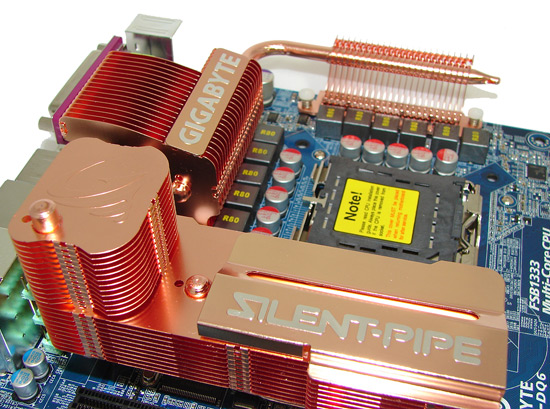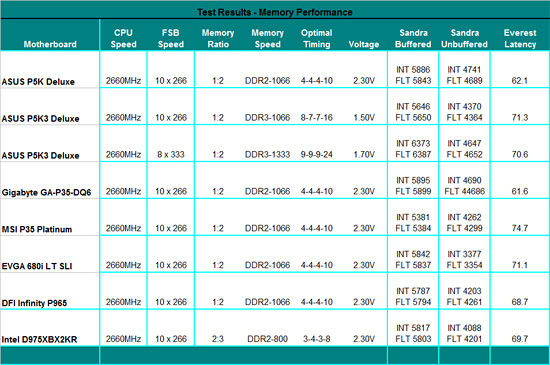Intel P35: Intel's Mainstream Chipset Grows Up
by Gary Key & Wesley Fink on May 21, 2007 3:45 PM EST- Posted in
- CPUs
Test Setup
| Standard Test Bed - CrossFire Test Configuration | |
| Processor | Intel Core 2 Duo QX6700 (2.66GHz, 8MB Unified Cache) |
| RAM | OCZ Reaper PC2-9200 (4x1GB) DDR2 4-4-4-10 Corsair CM3X1024 (4x1GB) DDR3-1066 8-7-7-16 |
| Hard Drive | Western Digital 150GB 10,000RPM SATA 16MB Buffer |
| System Platform Drivers | Intel - 8.3.0.1013 |
| Video Cards | 1 x MSI HD2900XT |
| Video Drivers | ATI 8.37.4.3 (HD2900XT Release Drivers) |
| CPU Cooling | Tuniq 120 |
| Power Supply | OCZ ProXStream 1000W |
| Optical Drives | Plextor PX-760A, Plextor PX-B900A |
| Case | Cooler Master CM Stacker 830 |
| Motherboards | Intel D975XBX2KR (Intel 975X) - BIOS 2692 ASUS P5K Deluxe (Intel P35) - BIOS 0304 ASUS P5K3 Deluxe (Intel P35) - BIOS 0011 MSI P35 Platinum (Intel P35) - BIOS 7345P01 Gigabyte P35-DQ6 (Intel P35) - BIOS F4 DFI Infinity P965 (Intel P965) - BIOS 424 EVGA 680i LT SLI (NVIDIA 680i LT) - BIOS P04 |
| Operating System | Windows Vista 64-bit Ultimate |
| . | |
Test conditions were maintained the same, as much as possible, over the platforms tested. Our game tests were run at settings of 1280x1024 HQ to ensure our GPU was not a bottleneck during testing. We will provide CrossFire results in our upcoming P35 roundup but preview performance numbers are available in this article.
All results are reported in our charts and color-coded for easier identification of results. We utilize new drive images on each board in order to minimize any potential driver conflicts. Our 3DMark results are generated utilizing the standard benchmark resolution for each program. We run each benchmark five times, throw out the two low and high scores, and report the remaining score. All results are run at stock speeds for this article although we will provide overclocked results in the next article.
Our choice of software applications to test is based on programs that enjoy widespread use and produce repeatable and consistent results during testing. Microsoft Vista has thrown a monkey wrench into testing as the aggressive nature of the operating system to constantly optimize application loading and retrieval from memory or the storage system presents some interesting obstacles. This along with the lack of driver maturity will continue to present problems in the near future with benchmark selections. Our normal process was to change our power settings to performance, delete the contents of the prefetch folder, and then reboot after each benchmark run. This is a lengthy process to be sure, but it results in consistency over the course of benchmark testing. All applications were run with administer privileges.

The test results we will present today are preliminary. What do we mean by this? Although the boards we are reviewing are full retail kits, their BIOS tuning continues at a rapid pace before the "official" launch on June 4th. Over the course of the last week we have tested numerous BIOS releases from each manufacturer and we've seen positive steps along the way. We honestly thought this preview would be a cake walk for ASUS until Gigabyte/MSI provided their latest BIOS releases that improved the performance of the boards up to 9% in certain areas.
We are also using early DDR3-1066 samples with memory settings at 8-7-7-16 for 1066 scores and 9-9-9-24 for DDR3-1333 results. We just received lower latency DDR3-1333 modules and will update our results in the roundup. On a side note, ASUS provided us a new BIOS for their P5K3 board that enables 1T command rates at DDR3-1066. Early testing has shown performance improvements up to 4% in memory sensitive applications. ASUS is continuing to work on the command rate timings and hopes to have 1T settings ready when low latency DDR3-1333 hits the market shortly. Expect to see an exclusive on this memory and BIOS in the next few days.
Our Intel Intel D975XBX2KR will be at a slight disadvantage, but with memory speeds set to DDR2-800 we were able to run timings at 3-4-3-8 without issue. We did not include extensive overclocking results for the CPU or memory side as time did not permit us to run each processor series on each board for the full test suite. We received seven boards late last week and will have results on several of those along with full overclocking results before Computex starts. We will also compare P35 1333/1066 DDR2 against P965 1333/1066 at the same time. Our DFI Infinity P965 is the fastest P965 board in our labs and as such is a good match for comparison.
Memory Performance
 |
| Click to enlarge |
We switched to a 4GB memory configuration for this article and future motherboard tests. The P35 chipset proves to have the fastest memory performance and best latencies at stock speeds provided the BIOS is tuned properly. We still find the 975X to offer some of the fastest memory performance when overclocked provided you can change strap settings and have very good RAM.
We noticed an 11% difference in unbuffered memory speeds and a 7% difference in latencies on the ASUS P5K Deluxe board when comparing auto to manually adjusted BIOS settings using the same standard 4-4-4-10 memory timings. Our other boards are tuned to the best possible performance that still allows the board to complete our benchmark test suite. We did not compare DDR2-1333 to DDR3-1333 for the simple fact that we currently do not have any DDR2 memory capable of 1333 speeds in a stable manner. However, we do expect DDR2-1333 RAM later this summer.










58 Comments
View All Comments
Comdrpopnfresh - Tuesday, May 22, 2007 - link
The power could be attributed to the DDR3. With it not being so mature there may be a lot of signaling going on that isn't necessary. Also- with all the new technologies, these boards simply have more going on on them. With more transistors on a cpu its is expected they will use more power- more connections and circuits on a board would mean the same. Everything is running faster too. The power consumption doesn't make sense given the lack of matching real-world performance enhancements, but as the article makes good sense in pointing out, Bios are a big contributing factor here.TA152H - Tuesday, May 22, 2007 - link
Except they ran the power tests with DDR2 on P35 based machines as well, and they were higher than P965 with the same memory. So, obviously, that isn't the cause in this instance.Gary Key - Tuesday, May 22, 2007 - link
After speaking with the board manufacturers and Intel, our original thoughts (briefings/white paper review) were confirmed that the additional circuitry required on the P35 DDR3 boards and in the MCH result in the increased power consumption on the DDR3 platform compared to the DDR2 platform. This holds true for the P35 DDR2 boards when compared to the DDR2 P965, the additional DDR3 circuity/instruction set is still active even though it is not being used. This is why you will see the DDR2/DDR3 combo boards shortly. However, the BIOS engineers believe that can work a little magic with the SpeedStep and C1E wait states to reduce power consumption, however we are talking just a few watts at best. More on this subject in the roundup, at least we hope we will have more... ;)TA152H - Tuesday, May 22, 2007 - link
Gary,Thanks, it's useful to know. Are they going to shackle the x38 with DDR2 support too?
Just confirms my earlier opinion, they should have gotten rid of DDR2 support. Intel is an interesting company, they can come out with a great product like the Core 2, and then have some monkey decide to include DDR2 and DDR3 on the P35. You never know if they'll have a clue, or not. I guess it's a good thing they make turkeys like this and the P7, otherwise we wouldn't have AMD. Although AMD might be the cause of this.
The monkey that decided to do this probably thought, "Oh, look what we can do that AMD can't". It seems to me they did that with the P7, a technological marvel way beyond AMD's capability to design, thank goodness, and the groundbreaking Itanium. Except neither one worked great. AMD's pragmatism has paid off nicely, and even though they can't realistically support DDR2 and DDR3 on the same motherboard, I don't think they really care. Of course, I'm just guessing, when a company does something this stupid, it's always difficult to understand why they did it. It would have been so simple to just have DDR3 support for the P35, and let the P965 handle the DDR2 crowd. It's perfectly adequate.
Thanks again for the information. It's disappointing, but with Intel you get used to it. They can't do everything right after all, and still be Intel.
strikeback03 - Wednesday, May 23, 2007 - link
There might be a more practical reason, such as lack of production capability for DDR3 or HP and Dell threatening to use VIA chipsets instead of P35 in order to keep using DDR2 and keep their prices competitive. I doubt consumers would like their prices increasing by a few hundred dollars for no noticeable performance improvement. And if they only keep the computer 3 or 4 years they will probably spend less on energy than on that DDR3.Who knows about X38, I'd guess DDR2 support won't disappear until the chipset revision for Nehalem.
TA152H - Wednesday, May 23, 2007 - link
Well, I agree if P35 were the only choice from Intel, this would be the case, but again, would you buy VIA if you could get a P965? I wouldn't. If the P965 were a lousy, and seriously obsolete chipset, yes, sure, you'd have to come out with something that replaced it. But they could have easily validated it for FSB of 1333, and at the point the only thing really new in the P35 would be the DDR3 support. So, why would you need it?I was going to get the P35 rather than the x38 because I figure x38 will be even more of a power hog considering the, to me, useless features it has. I don't plan on getting two high-end video cards, and I don't think I will run anything that requires twice the performance of the current PCI-E, but if they drop the DDR2 support, it might the one to go after. If you ever look at an Athlon 64 CPU, you can see the memory controller is simply enormous, so dropping it on the x38 could be significant. With it being high end, they may decide DDR2 isn't a high end technology so they drop it. I hope so.
JarredWalton - Monday, May 21, 2007 - link
Could be the Vista factor? I dunno what else to think about the power numbers.XcomCheetah - Wednesday, May 23, 2007 - link
Could you do a little testing on it... why so high power numbers..Secondly if i remember correctly the power number difference between 680i and P965 chipsets was greater than 20W.. but in your current tests the difference is pretty small.? So any guess what has caused this positive change.?
Reference
http://www.anandtech.com/cpuchipsets/showdoc.aspx?...">http://www.anandtech.com/cpuchipsets/showdoc.aspx?...
http://www.xbitlabs.com/articles/chipsets/display/...">http://www.xbitlabs.com/articles/chipsets/display/...
current power numbers on Anandtech
http://www.anandtech.com/cpuchipsets/showdoc.aspx?...">http://www.anandtech.com/cpuchipsets/showdoc.aspx?...